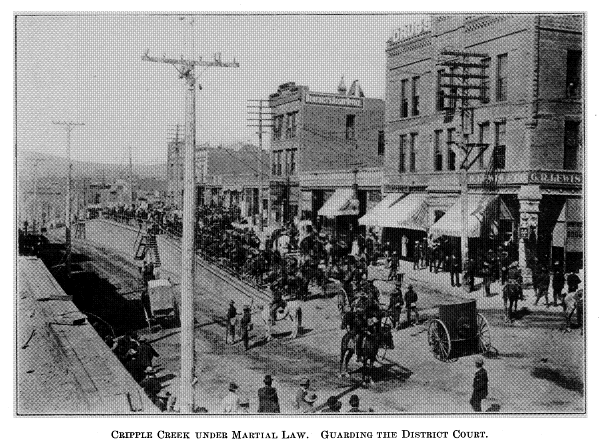Cripple Creek Miners’ Strike (1894)
Wed Feb 07, 1894

Image: Cripple Creek, Colorado under martial law, 1894. From Benjamin McKie Rastall, University of Wisconsin [Wikipedia]
On this day in 1894, miners in Cripple Creek, Colorado went out on strike to fight against wage cuts. The town was placed under martial law and brutalized by an illegal, mercenary army of deputies who had to be disbanded by state militia.
Prior to the strike, mine owners in Cripple Creek had attempted to expand the 8-hour day at $3.00 a day to a 10-hour day. When miners protested the increased hours, their employers kept the 8-hour day, but at a decreased wage of $2.50 a day.
Soon after these changes were implemented, organized miners became affiliated with the Western Federation of Miners (WFM). After mine owners ignored union president John Calderwood’s demands for an 8-hour day at the $3.00 wage, the union struck on February 7th, 1894.
By the end of February, every smelter in Colorado was either closed or running part-time. When some mines began to hire scab labor, the WFM tried to persuade these men to join the union and strike. When this was unsuccessful, the union drove the scabs out of the area with threats and violence.
After miners captured and assaulted six deputies, El Paso County Sheriff M. F. Bowers requested the intervention of the state militia (predecessor to the Colorado National Guard). Finding no apparent disorder on arrival, the state militia left Cripple Creek on March 20th.
After miners rejected an offer of $2.75 a day, mine owners secretly met with Sheriff Bowers and struck an agreement to fund a mercenary army of one hundred deputies (later expanded to 1,200) to police the region.
As word of the owner’s militia spread, miners began to arm themselves. Junius J. Johnson, a former U.S. Army officer, was recruited to take over strike operations. He ordered that fortifications be built, a commissary stocked, and the miners drilled in maneuvers.
On May 24th, strikers seized the Strong mine on Battle Mountain, which overlooked the town of Victor. The next morning, 125 deputies arrived in town. As they marched toward the strikers’ camp, workers at the Strong mine blew up the shafthouse and steam boiler, showering the deputies with timber, iron and cable, causing them to flee the area.
Following this incident, Governor Davis Waite issued a proclamation demanding that miners disband their fortifications on Bull Hill and declaring that the force of 1,200 deputies was illegal and to be disbanded.
Despite this, mine owners refused to disband the militia, which seized the town of Cripple Creek and began imprisoning and brutalizing hundreds of people. Owners only broke up the militia after Cripple Creek was re-captured by state forces and Waite threatened to occupy the area for the next thirty days.
This action was the only time in U.S. history when a state militia was called out in support of striking workers. Following a June agreement to give workers their 8-hour day at a $3.00 wage, more than 300 union members were arrested on a variety of charges. Only four were convicted, but they were quickly pardoned by Governor Waite.
The WFM became popular following the strike’s victory and used its success to organize almost every worker in the Cripple Creek region, including waitresses, laundry workers, bartenders and newsboys, also helping to elect a new sheriff.
- Date: 1894-02-07
- Learn More: en.wikipedia.org, progressive.org.
- Tags: #Labor.
- Source: www.apeoplescalendar.org
Great history lesson from my own state. Thanks for posting. I learned something new today.
Why didn’t they just start killing the mine owners?
Because they were cowering behind 1200 armed goons
Not at home asleep they weren’t.



